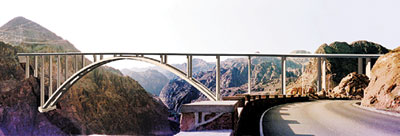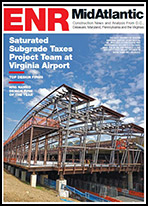Delayed reauthorization of the Transportation Equity Act for the 21st Century (TEA-21) held up the final $90-million piece of federal funding for the $234-million project. Victor M. Mendez, director of the Arizona Dept. of Transportation, and his Nevada counterpart, Jeff Fontaine, last month pledged $50 million each in GARVEE (Grant Anticipation Revenue Vehicle) bonds to keep the project moving. This stopgap use of GARVEE bonds could become more frequent as reauthorization continues its holding pattern in Congress.
"Other states will take note of Arizona and Nevada using GARVEE bonds to keep the project going," says Thomas R. Warne, a consultant and former head of the Utah Dept. of Transportation. "If it makes sense for their programs, they may pursue using GARVEE bonds as well."
 | |
 |  |
| KEY States provide stopgap funds to begin centerpiece arch span (model, above) while work continues on approach structures. FHWAs Zanetell says first phases are below estimate. (Photo top courtesy of the Federal Highway Administration; photos bottom by Tony Illia for ENR) | |
States have sold some $5 billion in GARVEE bonds since 1998, says Barney Allison, partner with Nossaman, Guthner, Knox & Elliott, a Los Angeles-based law firm. Since the bonds imply years of debt service payments before repayment in federal funding kicks in, "youre saying this project is a priority today," he adds.
The two-lane U.S. Highway 93, a key route in the North America Free Trade Agreement, traverses the crest of Hoover Dam and handles 13,000 vehicles daily. Since the 9/11 terrorist attacks, truck traffic over the dam has been rerouted 23 miles away, costing consumers some $30 million annually, says Zanetell. The bypass will provide a more direct route.
A team led by HDR Inc., Omaha, with Pasadena, Calif.-based Jacobs Engineering unit Sverdrup Civil and San Francisco-based T.Y. Lin International, designed the centerpiece span, tentatively scheduled to bid in September. Rising 890 ft over the Colorado River, it will be the longest concrete span in North America. Bidders can choose one of FHWAs suggested methodsusing dual towers with tiebacks to cast the span in place or erecting precast segments with cranesor propose other methods. The expected 36-month contract will be followed by a $15-million asphalt paving contract.
|
Construction on the overall route, which includes 4 miles of four-lane road, began last year. Using A+B bidding, the first two phases are at least 10% below engineers estimate, Zanetell says. The $21.4-million, 1.8-mile Arizona approach, built by R.E. Monks Construction Inc., Fountain Hills, Ariz., with Chino Valley, Ariz.-based Vastco Inc., is 85% complete.
Scheduled to finish by November, the project includes a 16.7-ft-tall diamond interchange with 1,300-ft-long ramps cut into mountain slopes to enable two lanes in each direction at a gateway road into the Lake Mead recreational area. Awaiting final girder placement is the 902-ft-long Sugarloaf Mountain Bridge over a 160-ft-deep ravine. The crossing consists of 77 prestressed, 128-ft-long concrete box girders, each weighing 132,000 lb.
The $30.1-million, 2.2-mile Nevada approach, built by Edward Kraemer & Sons Inc., Plain, Wis., is 30% complete and ahead of its October 2005 deadline. It includes six new bridges, including a 465-ft-long, cast-in-place box girder structure and a 12-ft-tall x 24-ft-wide culvert wildlife crossing at U.S. 93.
Due to rugged terrain and basalt, the project requires a total of 3.2 million cu yd of material to be excavated using drill-and-blast methods. Fencing and other measures are needed to protect endangered species such as bighorn sheep. The most challenging componentthe arch bridgeis yet to come.
tanding last month at the edge of a gorge 1,500 ft downstream from the Hoover Dam, Federal Highways Administration project manager F. Dave Zanetell marked the Boulder City, Nev., site where work may begin this fall on a 1,905-ft-long single-arch bridge. Its planned completion has been pushed back a year to 2008. Without a bi-state commitment to alternative funding, the delay could have been worse for the structure that will allow traffic to bypass the dam.
